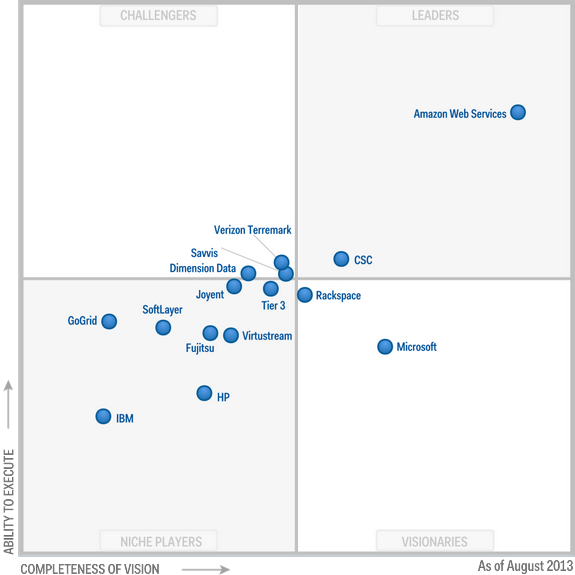If you’re involved in enterprise IT you ve undoubtedly seen one of Gartner’s “Magic Quadrant” charts. They cover everything from security software, to business intelligence, to data center networking. In every Magic Quadrant, you find the most attractive companies—the visionaries and market disruptors—in the top right hand corner. Vendors refer to these charts to explain their market opportunity; prospective buyers use them to select vendors. Gartner does not decide the future of technology, but the firm certainly documents it. The significance of Gartner’s work is why the recent Gartner Magic Quadrant chart on Infrastructure as a Service (Iaas) market should terrify the shareholders of companies such as HP, IBM, and Microsoft:

Source: Gartner Magic Quadrant for Cloud Infrastructure as a Service
I believe this chart is the most important chart in enterprise IT. It covers the new trend of IaaS, where instead of buying storage, operating systems, deployed applications, and other infrastructure, enterprises rent these products from vendors in a low risk pay-as-you-go system. It is a new way of doing enterprise computing.
There’s Only One Winner
Two things make this chart important. The first is the sheer size of the market. We are not talking about a specific vertical or a single technical use case. We’re talking about “where and how enterprise computing is done.” Computing infrastructure is the $150B a year “Big Kahuna”, where all the money changes hands, and where companies from Microsoft, to IBM to HP make all their profits.
What makes this chart scary is the second key takeaway: if IaaS becomes the dominant computing model, Amazon Web Services is the only possible winner. It cannot be emphasized enough how stark this chart is. As an IT investor, I have seen myriads of these charts over the past twenty years. The usual format is to show ten companies, give or take, tightly clustered in the upper right quadrant and across the other three quadrants, with highly nuanced relative positions. Since Microsoft dominated the operating systems market, I cannot recollect seeing such a stark and clear Magic Quadrant for a market already worth an estimated $4B and growing extremely rapidly.
Will IaaS happen for the enterprise?
What is still not clear is how much market share IaaS will take in the enterprise? Will it be 5%, 20% or even 80%? That is not yet clear and all caveats apply: infrastructure investments might not occur this way, enterprises may be slow to adopt IaaS, and the cloud could prove to have too many security issues. Even if IaaS does happen, established vendors already offer private cloud offerings and managed hosting products that replicate some of the IaaS advantages, but with a more controlled, enterprise friendly face. If all else fails, it’s possible that the cash-rich IBMs, Microsofts and SAPs will acquire companies and catch up to the market disruptors.
Even in light of these possibilities, it feels like we re in the middle chapters of a classic Innovators Dilemma story. AWS is cheap, flexible and evolving fast, with no ties to an installed base. In every platform shift, there are valid reasons why the incumbents should survive but, over time, the power of cheap, the power of flexible, and the power of new, sucks up all the profit dollars. I don’t envy the incumbents here. My gut tells me we are looking at the NCR, Bull, and DEC of tomorrow— great companies living off a residual of the past that got left behind in a platform shift.
Scale Ventures Partners’ Role
As VCs, we are in the revolution financing business, so revolutions are good for business. Right now we are looking for more companies that are poised to take advantage of this shift and even help accelerate it. Recent investments like Boundary, and PubNub assume a cloud based infrastructure and are working to improve it. Companies like Datastax build big data clusters that implicitly assume hundreds of additional servers can be spun up in the public cloud if required. Investments we have pending and the deals that we are evaluating today are all about taking AWS and adding the services that will make it enterprise grade. As we build our team, we are looking to add people who understand where the world is going and how starts up will profit from this shift from on-premise resources—and major capital investments—to a more flexible, incremental investment model.